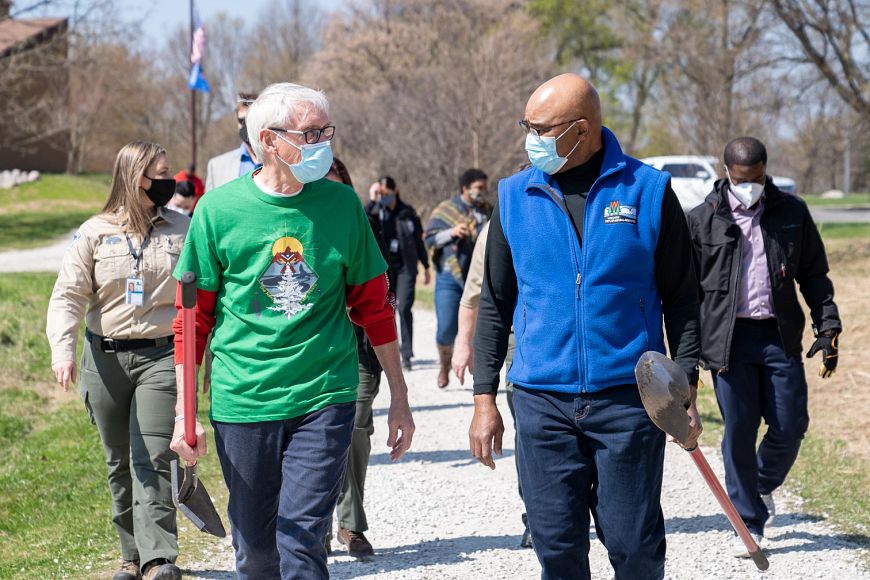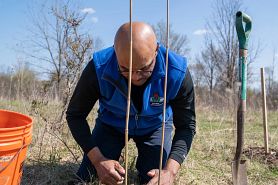From the Secretary
Preston D. Cole
 JOSHUA MORRISWisconsin Gov, Tony Evers, left, and DNR Secretary Preston D. Cole attend a tree-planting event at Milwaukee's Havenwoods State Forest to celebrate Earth Day 2021.
JOSHUA MORRISWisconsin Gov, Tony Evers, left, and DNR Secretary Preston D. Cole attend a tree-planting event at Milwaukee's Havenwoods State Forest to celebrate Earth Day 2021.Wisconsin is home to 84,000 miles of rivers and streams, 15,000 lakes, 800 miles of Great Lakes shoreline and 190 miles of Mississippi River shoreline. We truly have something special here.
And there’s nothing quite like summer in Wisconsin. Whether hiking, biking, kayaking, camping and more, there are so many ways to find your adventure.
While you’re out, take a moment to visit and really just appreciate Wisconsin’s forests. At the DNR, we’re responsible for managing 1.5 million acres of forested lands, including state forests, state parks, wildlife areas and other properties.
To help protect the planet and the people of Wisconsin, this past Earth Day 2021, Gov. Tony Evers signed an Executive Order pledging to protect and restore Wisconsin’s forestland by conserving 125,000 acres and planting 75 million trees by 2030 as part of the U.S. chapter of the global Trillion Trees Initiative.
To kick things off, together, we planted trees alongside volunteers at Havenwoods State Forest in Milwaukee — the state’s only urban forest.
When fully realized, the state pledge will result in 28.8 million metric tons of carbon dioxide stored over the next 50 years. That is equivalent to the amount of carbon dioxide produced by 6 million cars in a year.
Forests are woven into the culture of Wisconsin — where 17 million acres of forestland cover nearly half the state — and are vital to our social, ecological and economic well-being. Both the wide variety of forest-based recreational activities enjoyed by the public and the products made from our forests are crucial to the state and local economies.
In addition to safeguarding water resources, providing wildlife habitat and supporting rural economies, maintaining healthy forests is also essential to mitigating climate change.
 JOSHUA MORRISDNR Secretary Preston D. Cole, who began his natural resources career as a forester, knows well the vital importance of caring for Wisconsin's millions of acres of forestland.
JOSHUA MORRISDNR Secretary Preston D. Cole, who began his natural resources career as a forester, knows well the vital importance of caring for Wisconsin's millions of acres of forestland.To help retain forest cover, the state plans to use the Knowles-Nelson Stewardship Fund to continue acquiring forestland for state and nongovernmental entities. Additionally, the stewardship fund and other funding sources will be used to obtain conservation easements, preventing the conversion of forestland to other land uses.
Millions of trees will be planted each year on public and private lands in rural and urban settings with support from state programs. In most U.S. cities, the distribution of urban tree canopy disproportionately benefits high income neighborhoods.
A tree planting program targeting low-income urban communities would help to address inequity. Urban tree planting combined with enhanced tree maintenance can substantially increase urban forest carbon storage and deliver additional carbon mitigation benefits through energy savings.
Additionally, our state reforestation program will provide landowners hundreds of thousands of trees. Since 1911, the DNR has supplied Wisconsin landowners with more than 1.6 billion high-quality, native seedlings for reforestation. We also provide free tree seedlings for Wisconsin fourth-grade students to plant in honor of Arbor Day each year.
Dive into our Summer issue, as there is no shortage of interesting stories from across the state that might even provide inspiration for your travels. Whether highlighting the hard work DNR staff are doing to protect our amazing natural resources or sharing the personal stories of people enjoying them, I wish you happy reading!

